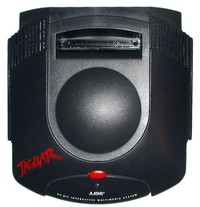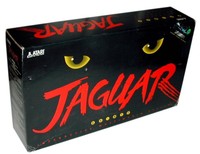Atari Jaguar
| Home > Browse Our Collection > Games Consoles > Atari > Atari Jaguar |
|
The Atari Jaguar was released by Atari Corporation in 1993. Developed after three years of research, and manufactured by IBM. It was originally bundled with Cybermorph, a technically impressive game, that although good, was not terribly interesting to play. Lengthy delays in producing new games was a constant frustration for owners, with many months passing with no new titles. The second wave of games was met with complete derision from the gaming press invited to the launch in London. Upon release, the Jaguar was criticized for its complex controller design, failure to distinguish itself from its 16-bit competitors, and perceived low quality game library. The console's multi-chip architecture made game development for the console difficult, not helped by having a very bugged development system. This led to some lazy ports from the 16-bit consoles, that used the onboard 68000 processor as the main CPU, which was not its intended purpose, this was just supposed to manage the other components. Underwhelming sales further contributed to the console's lack of third-party support, splitting the small amount of units available between multiple territories was a huge mistake. This in addition to the lack of internal development at Atari, led to a limited games library, comprising only 67 licensed titles. A CD-Rom drive was released in 1995, but delays in releasing software, and its unfortunate design, doomed it from the start, when sat on top of the console, with a memory track cartridge inserted, and its lid up, it does look rather uncomfortably close to a toilet! Although it was promoted as the first 64-bit gaming system, the Jaguar proved to be a commercial failure and prompted Atari to leave the home videogame console market. Despite its very low sales, the Jaguar has a large fan base that produces homebrew games, making the console a cult classic, a result of Hasbro buying Atari and releasing the Jaguar into the public domain. 5 Processors 'Tom' Memory 2MB DRAM Display 16.8 million colours of true colour palette. Programmable processor that can act as a variety of different video architectures, such as a sprite engine, a pixel-mapped display or character-mapped system. Our system is in the original box and packing. See our Making a Spin Controller for Atari Tempest 2000 page for detailed instructions and video. Manufacturer: Atari Other Systems Related To Atari Jaguar:
This exhibit has a reference ID of CH3330. Please quote this reference ID in any communication with the Centre for Computing History. |
Click on the Image(s) For Detail
|














